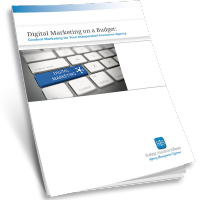
Agency Accounting, Agency Operations, Marketing
It’s a new year and you’re ready for a fresh start. You’ve made your resolutions and one is clear: get more business!
What are you waiting for? Ready, set, GO!
“Go where?” you may wonder. You’re not alone. A recent Outbound Engine report showed 24% of respondents didn’t know where to focus their insurance marketing efforts.
How can you make moves in marketing when you don’t know where to go? The first step is finding out what works from those who’ve tried it. Check out these top insurance marketing blogs to help you and your agency follow through on your resolution this year.
Read more on how to set and achieve your agency goals in the New Year
Insurance Marketing Resources
- Media Blog: Chock full of tips and tricks to manage social media marketing, from set up to strategy and beyond. A great starter for those just dipping their toes into the social media waters.
- Agency Updates: The brainchild of Robyn and John Sharp, this blog covers everything from social media marketing strategy to day to day agency management. They share monthly marketing plans to help you prepare for every season, complete with downloadable calendars to keep you on pace.
- Digital Marketing Experts Blog: The name says it all. This blog covers all aspects of digital marketing: content creation, strategy, lead generation, referrals, and everything in-between. Plus, there’s weekly news articles sharing what’s happening in digital marketing today.
- leadPops Blog: leadPops specializes in providing marketing and lead generation solutions for insurance agencies. They provide tips for online, offline and referral marketing through a variety of content types. And, their info is easy to digest and focused on giving you the most bang for your buck.
Check out six other industry blogs to add to your daily routine
- Inbound Insurance Marketing Blog: Inbound Insurance Marketing President Heather Sloan grew up in the insurance industry. Her expertise and experience shine through as she focuses on how to help agencies target their specific customer demographics. The blog covers big topics like how to map buyer decisions to a marketing strategy and offers small tips like how to come up with creative content. It’s practical, readable, and relatable.
- Paradiso Presents: Chris Paradiso founded Paradiso Insurance in 1998 and has been showing agencies how to leverage digital and social media ever since. Paradiso uses real-life examples from their own social and digital marketing, covering brand building, blogging, and overall social strategy among other topics.
Putting it into Practice
Now that you’ve got your ideas, it’s time to put them into action. This can be particularly challenging if it’s your first foray into digital marketing and your budget is tight.
That’s why we created one of our most popular eGuides: “Digital Marketing on a Budget.” You can access the full guide on our resources page. And, get even more marketing resources on our blog at sispartnerplatform.com/blog.
See something missing? Let us know! We’re always looking for more ways to help independent insurance agencies grow their business. Contact us at [email protected] or visit our contact page to fill out a form and we’ll be in touch.

Agency Operations, Marketing
Insurance agency marketing is a game of results. Whether you hire an experienced producer or build a sales team from scratch, there are performance expectations. But, expectations without structure is a recipe for disappointment. Consistency and focus are key ingredients for any person or organization to sell successfully,
How can you create structure that encourages consistency and focus within your agency? Below are a few steps to get you started.
First, establish good data habits.
Rather than an exclusive focus on results only, pay attention to the habits that breed them. Reliable, complete data entry is one such important habit. Once you’ve established a culture of entering data in your management system, you can access the building blocks to sales success: quality data and performance metrics.
- Quality data means data that is complete and accurate. Get your employees in the habit of filling out prospect and client information in a set way. Incomplete or inaccurate data can throw off your entire sales strategy.
- Performance metrics are established using the quality data you have to know where you are and plan where you want to go.
Read more on establishing and tracking metrics to inform agency growth
Next, identify leading indicators.
Leading indicators are the actions that happen leading up to a sale. Take a look at what you’re doing to gain customers and record what’s working. Establish goals with each and map out sequencing for prospects. Examples of leading indicators include:
- Phone calls: net new phone calls, as well as follow up. Differentiate between the two as they drive different results.
- Conversations (including emails): pay attention to the quantity and quality of conversations you’re having and who they’re with (prospect vs. client).
- Appointments: how many net new appointments and follow up appointments are held each week.
Find out how to motivate your producers for sales success
Finally, measure results-driven indicators.
Coming after leading indicators, these are the results that show something has happened. Examples of results-driven indicators include:
- Quotes or proposals requested: establish stages for requesting and track them.
- Quote submitted and reviewed: identify these as well-qualified selling opportunities.
- Quotes won and lost: …and the reasons why. Use these indicators to determine how to improve your sales process.
Learn more on tracking and predicting customer behavior
Sales excellence is not a one-time event nor does it happen randomly. Anyone can win a few deals. To build a career, it takes attention to doing the little things right each day and building on that.
Your agency management system is a big part of those small steps. Recording, reporting on and analyzing agency data are foundational to identifying performance metrics and sales indicators that help form an effective sales strategy. If your management system is intuitive and adaptable to your agency, it’s reflected in your sales process and overall agency performance.
See how Partner XE adapts to your agency’s needs with personalized workflows
At SIS, we pay attention to and understand this ripple effect. That’s why we regularly update our Partner XE management system based on our partner agencies’ input and direction. Thanks to this close partnership, we continue to improve Partner XE system operations, making data storage and processing easier so you can run your agency better.
Find out what Partner XE and SIS can do for your agency. Get in touch with us to view a demo and talk with a SIS staff member today.

Marketing, Technology Trends
The Case for Customer Retention
There’s an adage that getting new customers is expensive, but keeping them is profitable. Insurance agency owners know this conundrum. Yet, owners continue to struggle with investing in their insurance agency marketing.
A 1990 study by Bain & Company and Harvard Business School’s Earl Sasser famously showed that increasing customer retention rates by 5% can increase profitability by 25-95%. A recent Invesp infographic backed up the case for customer retention, showing it costs five times more to attract a new customer than to keep one.
For insurance agencies, customer retention is especially important: personal and commercial policies can take two to three years to show profit based on commissions paid. Keeping customers around for those two or three years becomes important.
Digital Marketing: Your Customer Retention Boost
Digital marketing allows you to communicate with your customers more effectively and at a lower total cost per impression than ever before. Plus, digital marketing lets you capture information on customer engagement and preferences to continually improve your tactics.
Follow these 8 steps to bolster your agency’s digital footprint
Take a digital newsletter, for example. With today’s technology, you are easily able to write, mass distribute, and collect information on exactly how your customers are interacting with that newsletter. You quickly pull a distribution list from your management system, create the newsletter using agency blog posts, and track interactions through your newsletter distribution platform.
That same newsletter content can be posted to Facebook, Twitter, LinkedIn, Google+, and other areas where your customers engage with your agency. This helpful content can be customized per channel, and all serve to help drive pertinent information to your clients, directing them back to your site for more.
Find out how to do digital marketing…on a budget
And you know what’s happening every step of the way. Through this simple process, you can capture what’s working and where your customers are going. You’ll get stats on who’s visiting your website, accessing your blog, and leveraging your self-service portal among other information.
With this information, you can reach out via phone to touch base. You’ll be armed with the knowledge of what they viewed, giving you insight into what they need, and inviting to help them with more.
It beats the heck out of sending a postcard.
Get Connected through SIS
If you aren’t fighting for space in your customers mindshare – no matter how small that space is – you are essentially surrendering it to your competition. The best way to fight for that space is to get the right tools and tactics. At SIS, we work with our partners at NuGrowth Digital to stay up to date on industry marketing trends, providing solutions through our marketing arm Agency Marketing Partner. And, we continually collaborate with the Partner XE community to integrate the Partner XE agency management system with the latest marketing tools.
Agency Operations, Marketing, Technology Trends
 A recent SIS survey revealed 54% of agencies are “neutral” on how they view their marketing success. “Some days we see results, some days we don’t. Overall, we’re unsure of our success,” many reported. This kind of vagueness is unsettling—how can an agency improve its marketing efforts without a clear picture of its current status?
A recent SIS survey revealed 54% of agencies are “neutral” on how they view their marketing success. “Some days we see results, some days we don’t. Overall, we’re unsure of our success,” many reported. This kind of vagueness is unsettling—how can an agency improve its marketing efforts without a clear picture of its current status?
To add to the problem, 66% of agencies budget only 1-5% for marketing[1].
(more…)
Marketing
 Creating and maintaining your agency’s digital presence is a must for success. Agency online visibility has moved from beneficial to necessary, and with it comes the challenge of digital marketing. No matter how engaging your agency’s website is, if no one can find you it’s all for naught.
Creating and maintaining your agency’s digital presence is a must for success. Agency online visibility has moved from beneficial to necessary, and with it comes the challenge of digital marketing. No matter how engaging your agency’s website is, if no one can find you it’s all for naught.
So, how can your insurance agency increase its digital marketing? There are a host of tactics, but here we’ll focus on keywords in search engine marketing.
The What
Search Engine Marketing (SEM) focuses on increasing your website’s rank in online searches. There are a few SEM tactics marketers use, including backlinking and utilizing relevant keywords.
Keyword targeting is the most popular and effective, and what we will focus on in this post. Search engines have “crawlers” that take in the information on your website (text on page and metadata) and rank it based on its relevance to the search terms. Your site’s relevance increases if the search terms appear often, yet in a natural, logical way.
The Why
The majority of websites are found via online searches, and generally users focus on the first two pages of results. By paying attention and using highly searched keywords on your website, you can increase your agency’s page rank.
The How
- Assess your keyword needs. Find out the search terms that lead individuals to your agency’s site. Google’s Keyword Planner can provide this information, as can your site’s webmaster tools. Generally, local keyword strings have the highest digital insurance marketing impact (i.e. “insurance Columbus, OH”).
- Use your keywords. Once you’ve identified your keywords, use them on your website. Certain areas of your site have a greater impact than others. Focus on using your keywords in page and content titles, page URLs, and in image file names and alt tags. In the body of a page, try to use your keyword phrase three to five times, ensuring it also makes sense and is natural.
- Monitor impact. Keep track of how different keyword phrases are performing and adjust as needed. You may find some are not searched as often, or that new phrases need to be added as you add services or the industry changes.
- Consider an SEM agency. Search Engine Marketing can easily turn in to a full time job. Your agency can make an impact with any targeted efforts, but if you have the resources to outsource it is worth the investment.
The key to effective SEM is paying attention to how your site is viewed by search engines and users. This can be a challenge, especially in the rapidly changing insurance industry. As new tools and services are introduced, your search terms may change and your website should reflect those changes.
SIS can help your agency stay up to date on industry trends with our recent blog posts, including a focused section on insurance technology trends. Check out our resources page for even more educational materials, or contact us with your questions and comments.




 A recent SIS survey revealed 54% of agencies are “neutral” on how they view their marketing success. “Some days we see results, some days we don’t. Overall, we’re unsure of our success,” many reported. This kind of vagueness is unsettling—how can an agency improve its marketing efforts without a clear picture of its current status?
A recent SIS survey revealed 54% of agencies are “neutral” on how they view their marketing success. “Some days we see results, some days we don’t. Overall, we’re unsure of our success,” many reported. This kind of vagueness is unsettling—how can an agency improve its marketing efforts without a clear picture of its current status? Creating and maintaining your agency’s digital presence is a must for success. Agency online visibility has moved from beneficial to necessary, and with it comes the challenge of digital marketing. No matter how engaging your agency’s website is, if no one can find you it’s all for naught.
Creating and maintaining your agency’s digital presence is a must for success. Agency online visibility has moved from beneficial to necessary, and with it comes the challenge of digital marketing. No matter how engaging your agency’s website is, if no one can find you it’s all for naught.